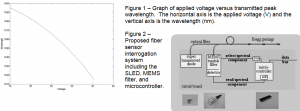Seth Lloyd and Dr. Richard Selfridge, Electrical and Computer Engineering
Optical fiber sensors offer a viable alternative to traditional electronic sensors because of their small size and high immunity to environmental phenomena. While many researchers focus on developing and applying new optical sensing technologies, there is also a great need for better fiber sensor interrogators. An interrogator is the system used to collect the data from the sensor, which with optical sensors usually involves the transfer of an optical signal to an electric signal. The current equipment required for interrogating fiber optic sensors tends to be large, bulky and costly, has high power consumption, and usually performs only the most basic functions. There is a need for smaller, faster, and more flexible interrogating systems.
Recovering information from an optical signal usually requires a spectrum analyzer. The power in the signal at different wavelengths of light must be determined in order for the necessary information to be collected. There are generally two approaches for spectrum analysis. One method scans the light source across a range of wavelengths and uses a detector at the output to measure the power corresponding to the different inputs. However, these sources, such as a tunable laser, tend to have high power consumption. The other approach uses a broadband source, one that simultaneously emits a range of different wavelengths, and then uses a tunable filter on the output to measure the power for different wavelengths. Though tunable filters do not have the high power consumption of a tunable laser, their operating speeds greatly limit their application in fiber sensors. Recently, however, a microelectromechanical systems (MEMS) based tunable filter was developed with operating speeds 1000 times faster than existing devices.
In order to determine if the MEMS filter could be applied to an interrogation system for a fiber optic sensor, the filter operation first had to be characterized. We first used a broadband ASE (amplified stimulated emission) source to illuminate the filter while monitoring the output of the filter using an optical spectrum analyzer (OSA). By applying a voltage across the tuning pins of the filter, we expected to adjust the wavelength of the light that the filter allowed to pass. However, because the filter we tested was not operating in the range we expected, we initially had a hard time detecting that any power was being transmitted. Nevertheless, after adjusting our instrumentation to check a wider range, we were able to observe a transmitted peak in power that corresponded to the voltage applied to the filter.
We next designed a program using Labview on a PC to characterize the relationship between the applied voltage and the transmitted wavelength of the filter. Using a tunable laser with a line width of approximately 10pm and a photodetector, we designed the program to scan the filter across its entire range (0V-40V) while monitoring the power measured at the photodetector. After each scan of the filter, the program adjusted the center wavelength of the tunable laser. The scan would then be performed again. In this manner, we created a mapping from the applied voltage to the transmitted peak wavelength (see Figure 1). In order to simplify the use of the filter with an optical sensor, we had hoped that the relationship would be linear. Although the result was not linear, it was sufficiently smooth to allow for a simple correlation between the applied voltage and the transmitted wavelength.
Our next step was to characterize the temperature response of the filter. One of the main reasons that interrogation systems have high power consumption is the use of thermo-electric coolers (TEC). A TEC is necessary in order to ensure that the electro-optic devices used in interrogation do not drift with temperature; however, TECs consume a lot of power. We wanted to determine how temperature would affect the filter operation in order to decide if the filter could be used without a TEC. Using an external temperature controller, we varied the filter temperature from 10°C to 50°C while fixing the input wavelength and the applied tuning voltage on the filter. Using our Labview program, we monitored the transmitted peak wavelength as a function of temperature. As expected, the transmitted peak drifted with temperature. However, as we had hoped, the drift was approximately linear. Thus we expect that without using a TEC we can use software to offset the temperature drift of the filter, ensuring that data collected using the filter is still valid.
Having characterized the filter operation, we proposed a complete interrogation system using the filter. This novel interrogation system replaces traditional bulk components with their much smaller and cheaper counterparts (See Figure 2). The source for the proposed system is a superluminescent light emitting diode (SLED) that also does not require a TEC. We acquired a MEMS filter with built in photodiode to filter and measure the spectral power. Finally, in place of a PC, we proposed using a microcontroller to drive the filter and perform data analysis. The resulting system can all be assembled on a printed circuit board approximately the size of a PDA.
We built a prototype of the proposed system and are in the process of testing its functionality. In order to achieve reliable operation, we will need to improve the signal to noise ratio. Because we have both analog and digital components, this will require implementing specific design practices to remove sources of noise. We have performed several tests of our system using a tunable laser to simulate an optical sensor such as a fiber Bragg grating. Based on these tests, we expect the proposed system to be a practical alternative to traditional fiber sensor interrogation systems.

